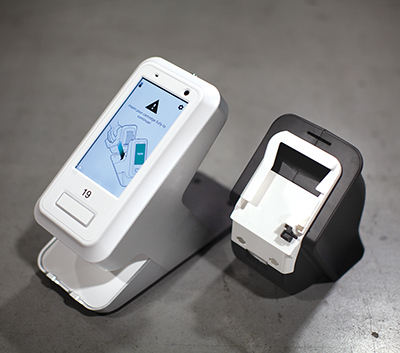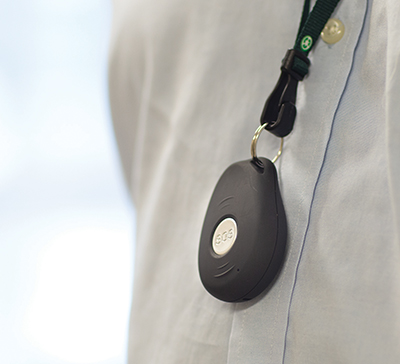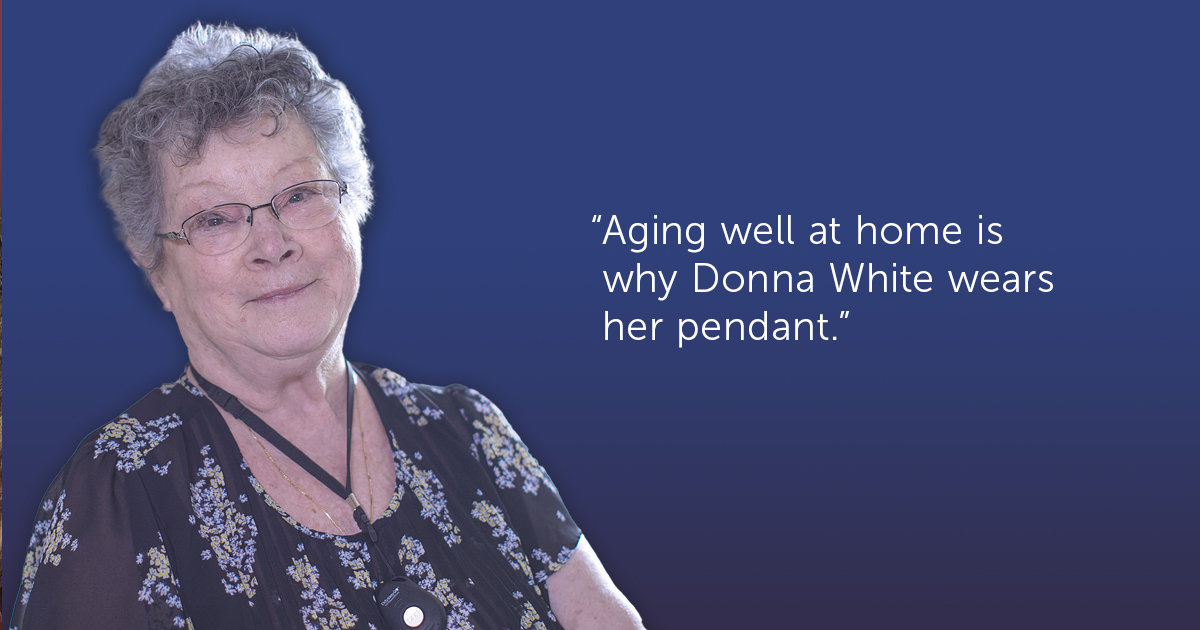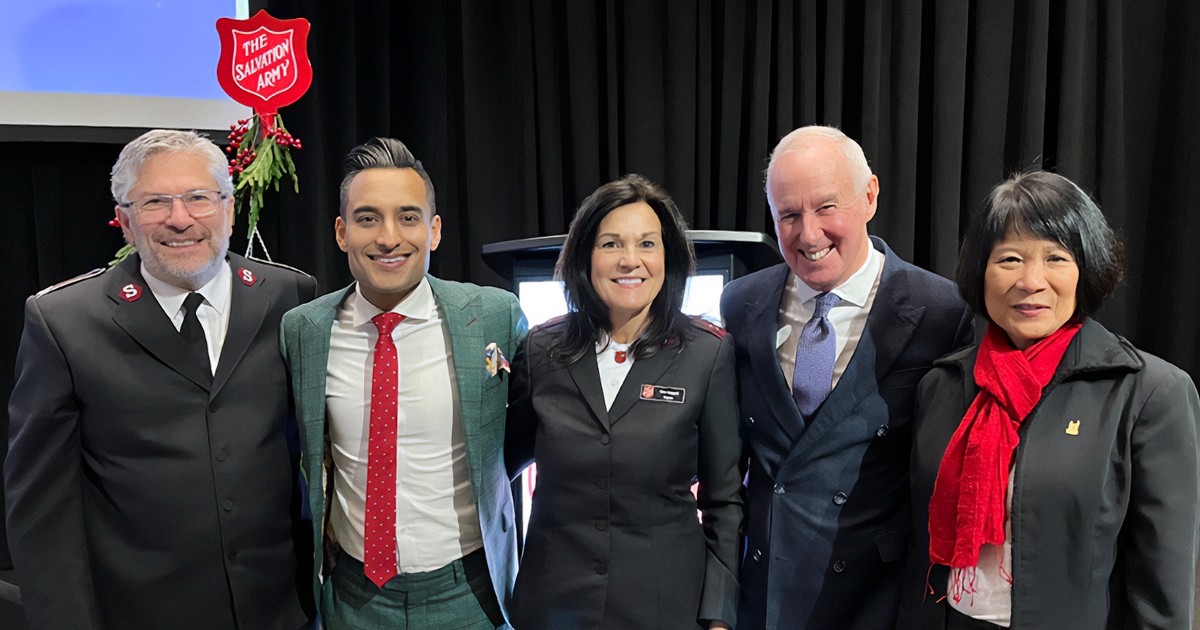(Above) Donna White is one of more than a thousand people currently enrolled in The Salvation Army Toronto Grace Health Centre’s Remote Care Monitoring program. Her medical alert pendant provides assurance that help is available at the push of a button (Photos: Eric Gerard)
After falling while filling bird feeders in her sister’s backyard, 77-year-old Donna White started to panic. With two artificial knees preventing her from standing up without holding on to something, the “what ifs” started to play loudly in her head. What if I can’t stand up? What if I can’t find a way out of the backyard? What if no one can hear me call for help?
Her sister and brother-in-law, whose house she was looking after, were away for the month, and their neighbours were nowhere in sight that March afternoon.
Inching her way toward the house’s back door, hands and knees soaked with snow, shivering from the cold, White made herself a promise: she would get what she calls “an alert button.”
“I knew it could have been really bad. And I’ve had quite a few falls—I probably average at least two a year,” White says.
Today, if she does fall, there’s help at the push of a button.
Aging in Place
White heard about The Salvation Army Toronto Grace Health Centre’s Remote Care Monitoring (RCM) program from a friend at her seniors’ residence. The pre-pandemic brainchild of health centre CEO Jake Tran, it was designed to help older or at-risk patients stay in their homes while still receiving hospital-level care, also freeing up in-demand acute care beds. The onset of COVID-19 accelerated Tran’s idea into a full-fledged pilot project in the summer of 2020.
“We were asked to open up 20 beds for chronic ventilators,” says Tran. “But where would we put those 20 patients? We knew we had the RCM system in place, so we decided to take it to the next level, allowing us to then not rely on institutional responses but use the clients’ homes. We call it aging in place.”
Funded by public and private donors, this aging-in-place system provides medical and non-medical monitoring by a Toronto Grace team, 24 hours a day, seven days a week.
Levels of Care
Eighty to 90 percent of the program’s patients need only its basic services, like White, who wanted a medical alert device to help her feel safe day-to-day. She uses the Odyssey device, worn as a pendant, a watch, or even attached to a belt clip, where it detects falls or unusual movements and notifies Toronto Grace staff. It also permits geo-fencing for patients prone to wandering, sending alerts to family members or the RCM team if they leave set geographic parameters. Direct, two-way calling allows clients to call for help by pushing a button.

Technology providing a deeper level of care is also available, including devices that monitor blood pressure, oxygen levels and body temperature, along with a machine known as the Karie, programmed to dispense medication at specific times and to the right person (by means of facial recognition technology). There’s also the option of in-home passive monitoring: a series of sensors that learn the client’s movements and trigger a warning if they detect something out of the ordinary, such as a lack of movement.
All devices report back to a centralized portal that tracks patients’ individual health information, collating the data and providing the RCM team with a full picture of how patients are faring and whether interventions are required. This team includes a range of doctors, nurses, therapists and social workers.
Room to Expand
The RCM program now serves clients across the Greater Toronto Area, but, with the right funding and support, Tran hopes to take the program province-wide by the end of this year.
“It’s a beautiful way of getting people home (from the hospital) and helping those who are at home stay there,” says Tran. “It is not the answer to everything. But it is the beginning of a different type of medical care.”
And in the wake of COVID-19, a different type of medical care, where older Ontarians can stay in their homes—and out of longterm care facilities—seems to be exactly what the province needs.
Peace of Mind
Statistics from the Canadian Institute for Health Information, a non-profit that studies Canada’s health system and the health of Canadians, show long-term care residents accounted for just three percent of all COVID-19 infections, but 43 percent of deaths from the virus. Long-term care homes became a dangerous place for many during the pandemic.
And studies from the Journal of the American Medical Association show patients receiving care at home versus in hospital have a lower risk of hospital readmission, a reduced risk of long-term care admission and lower depression and anxiety rates. It seems receiving care at home is good for your health.
Laurel Franks can tell you how good Toronto Grace’s RCM program has been for her patients. The Toronto Western Hospital social worker has referred clients to the program for almost a year, primarily for the Odyssey pendant. She still remembers the first patient she referred.
“It took away this layer of anxiety for us as his care providers and for him, because he lives alone and really has nobody else in the world,” says Franks. “If he fell or needed support, no one would know. This is a huge deal to him. And the peace of mind that everybody felt when he came into the clinic wearing his pendant—I could cry just thinking about it.”
Financial Impact
Franks says medical alert devices from for-profit companies carry a cost prohibitive to many of her clients. Neither do they provide the extended care possible with Toronto Grace’s program. The cost to patients referred to the RCM system? It’s free.
Compare that to the cost of not investing in an outside-of-the-box (and outside-of-the-hospital) program such as this. Alan Ruth, CEO of GRT Health, which supplies Toronto Grace’s RCM technology, adds it up.
“My estimate is that in Ontario, there are about 100,000- plus people who would benefit from access to the Grace’s RCM program,” says Ruth. “For acute level of care patients, if they’re institutionalized, the direct cost is about $800 a day. If they wind up in long-term care, it’s about $400 a day.
“The cost to build a hospital bed is about $1,000,000, and you don’t just build one hospital bed, you build units of 35 or more,” he continues. “Then you’ve got the cost of the build, the cost of maintaining it and the cost to operate. On top of that, there’s scalability. If I say we need another 35 hospital beds in Toronto, they may not be built in the next three to five years. But if somebody calls the RCM program and says, ‘I’ve got 35 people I need to put on,’ well, we’re now averaging about 11 to 15 referrals a day. The scalability is technically infinite.”
Accessibility for All

Also infinite, says Franks, is what a province-wide remote care program like this could mean to the health-care system she has worked in for almost a decade.
“It could mean everything,” she says. “In a province that’s struggling, it seems common sense. It would change how people feel about aging in place. It would make that opportunity accessible (to everyone). It could mean unneeded long-term care placements and hospitalizations, shortened hospital stays, and happier, less scared people. It’s multifactorial in terms of how it could impact people.”
For Dawn Tobler and her family, the impact has been deeply personal. Her mother, Shirley, was diagnosed with dementia two years ago, and wears a Toronto Grace pendant like a watch on her wrist. Because she’s prone to wandering, Shirley’s device sends a text alert to Tobler or her husband if she leaves a designated area around her building. Which is exactly what happened one morning last winter, when they were awoken by a 5 a.m. text message showing Shirley blocks away from her building. Tobler called her mother, told her to stay put, and was able to bring her safely home.
“We swear that saved her life or saved her from getting sick or falling,” says Tobler. “It’s reassuring to know there’s a community out there, checking in on her. I appreciate it and know my mom deserves that help.”
Life-Changing Care
That help now extends to more than 3,000 people like Shirley; that’s exponential growth considering the RCM program only served 75 clients less than two years ago. Who is the clientele?
“Eighty-five percent of our clients are older adults who are frail and many are marginalized,” says Tran. “This is one way in which they can truly age at home.”
Aging well at home is exactly why White wears her pendant. She organizes regular bridge, euchre and movie nights in her seniors’ residence. She still drives, taking friends to appointments or the grocery store. She sees her sister often, popping in with coffee. She visits her son regularly. Being able to continue doing all of this with a sense of security means everything.
“I just feel safe,” White concludes. “I can’t put it into any better words than that: I feel safe.”
Jane Ayer is a communications consultant in the internal communications department at territorial headquarters.
This story is from:










Leave a Comment